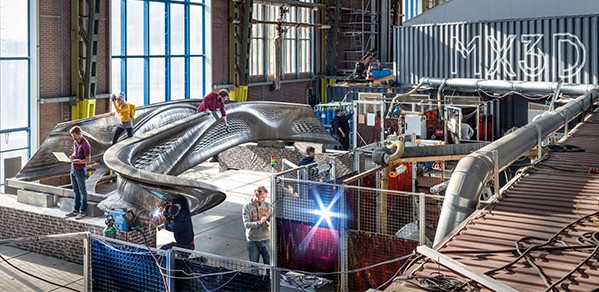
An innovative 3D metal printed bridge – the first of its kind that allowed partners, including the University of Cambridge, to experiment with new technologies like Internet of Things (IoT) systems, Digital Twins and 3D printing – has received a prestigious award.
This project was an exciting and convincing realisation of convergence science, where we merged diverse areas of expertise to address the complex construction problem presented to us.
Professor Mark Girolami
Dutch scale-up MX3D has been awarded the “Outstanding Development in Welded Fabrication” by the American Welding Society (AWS) for the “MX3D Bridge” – unveiled in Amsterdam and opened by Queen Máxima of the Netherlands in 2021.
Past winners of this award include the Hoover Dam, the Grand Canyon Skywalk and the New York One World Trade Center, the Mars Curiosity Rover, the PipeLine Under The Ocean (PLUTO), and the Panama Canal.
The MX3D Bridge measures 12 metres and was designed by Joris Laarman lab in collaboration with lead engineer Arup. It was fabricated with MX3D’s proprietary robotic Wire Arc Additive Manufacturing (WAAM) technology, which is 3D metal printing with welding robots controlled by MX3D’s MetalXL workflow.
The MX3D Bridge was also equipped with an innovative sensor network, linked to a mathematical computer model forming a Digital Twin of the physical bridge and its digital representation. The Digital Twin monitored the bridge performance in real-time, and in effect, served as a living laboratory, with pedestrians, cyclists and runners generating data every time they crossed the bridge. This data also helped to monitor the MX3D Bridge’s structure and provide information about how it was being used.
The sensor network was designed and installed by a team from the Turing Data-Centric Engineering (DCE) programme that comprised structural engineers, mathematicians, computer scientists and statisticians, including researchers from the Cambridge Centre for Smart Infrastructure and Construction (CSIC). The MX3D Bridge will remain a platform for innovation at its new location, which will be announced shortly.
The whole project was brought to life thanks to the support of industry leaders including Autodesk, ArcelorMittal, ABB, Air Liquide, and Lenovo. Additional funding by the Dutch RVO and Lloyd's Register Foundation helped MX3D realise its bold vision for autonomous 3D metal printing of large structures.
Professor Mark Girolami was project lead at the time. He is also Chief Scientist at The Alan Turing Institute and Sir Kirby Laing Professor of Civil Engineering at Cambridge.
Professor Girolami said: “Realising the vision of providing the world’s first pedestrian bridge using 3D printing technology required us in Data Centric Engineering at The Alan Turing Institute to bring together a multidisciplinary team. This team consisted of material scientists, structural engineers, and mathematicians working on stochastic geometry and continuum mechanics, alongside data scientists, machine learning experts, and a team of engineers from the CSIC.
“This project was an exciting and convincing realisation of convergence science, where we merged diverse areas of expertise to address the complex construction problem presented to us.”
Gijs van der Velden, CEO of MX3D, said: “Receiving the ‘AWS Outstanding Development in Welded Fabrication Award’ for the MX3D Bridge is a remarkable honour. This award highlights the innovation, collaboration and perseverance that went into bringing the MX3D Bridge from concept to reality. I am really proud of the close-knit team of partners that pushed the boundaries of what’s possible with welded fabrication.”

